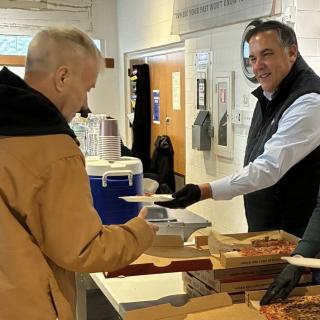Advertisement
The first “alt rock” song to ever travel Columbus radio waves was Echo & The Bunnymen’s “Rescue.” Sure, it may not have been the very first progressive rock song played locally. But let’s just call it the truth because this story harkens back to a more fun, more weird, and more cool Columbus.
The year was 1989. The Berlin Wall was crumbling, and in America, alt rock or progressive rock was making the cool kids lose their freakin’ “I can’t listen to this glam and classic rock anymore!” minds. The station playing Echo & The Bunnymen was 107.1 FM WLRO out of Circleville, an adult contemporary station and able to reach Columbus. It was a Sunday night, and the 31-year-old radio personality who played “Rescue” was a former Ohio State campus kid looking to bring a full-time alt rock station to Columbus.
“The second I played that first song, the phones went absolutely crazy,” says the now 60-something Gary Richards. That’s him in the suit in the above black and white photo. “The show was an instant sensation.”
He named his show “Radical Romper Room,” a play on the kid’s television show at the time. It was three hours of nothing but this new-fangled “alternative” sound, which in its early days encompassed punk rock (The Ramones), new wave (the Cure), and “college rock” (R.E.M.).
Surreal is how he was able to convince the radio station manager in Circleville to begin playing those bands along with The Smiths, Sex Pistols, Violent Femmes, etc.
Money would do the talkin’, thought Richards back then, and he knew exactly where to turn for support. High Street near off-campus and the Short North, and at that time, all of it was pre-Campus Partners. Independently owned establishments where the cool kids bought their music, beer in mop buckets, dime bags of brick weed, and gyros.
He began pitching the show to stores and bars the cool kids loved. Monkeys Retreat bookstore, Atlantis clothing store, Crazy Mamas, Mean Mr. Mustards, and up and down High Street and through the Short North, he went.
“I said, ‘Hey, I’m going to do an alternative rock show on an FM station here in Columbus. Will you advertise? And I had a dozen of them say ‘Yeah!’ and I got them to sign on the dotted line,” he said.
In a sales meeting at 107.1 FM, he showed the station’s manager the contracts. The manager commended him, and that is when he pitched the idea for Radical Romper Room.
“He was very skeptical. He said, ‘Well, I don’t want anything wild going on over there.’ I told him don’t worry about it.”
Richards is now retired from the media landscape, and full disclosure, he sold ad space for the Free Press for several years, keeping Columbus’ last independent newspaper afloat month after month. He was first exposed to alt rock in the late 1970s when his dorm buddies at Ohio State began coming home from the record store with music that he “frankly thought was nuts.”
“At the time, my friends and I were into progressive rock such as Yes, Pink Floyd, and Genesis, and then suddenly they began coming home with Elvis Costello, The Ramones, and Sex Pistol albums,” he says.
In 1982, not long after graduating from Ohio State, he took a job managing an audio-visual contractor for hotels and convention centers, a job which would transfer him to Virginia.
“It was there that I discovered a radio station that was the inspiration for CD101,” he says. “It was WCWM at the College of William and Mary. I wasn’t even in radio yet. But I thought, ‘Damn, a station like this would really fly in Columbus’. Because Ohio State, the largest campus in the country, did not have a student run radio station. Which was crazy.”
He fell in love with this new sound. So much so, he began recording the channel on cassette tapes.
“But I wanted to get back to Columbus where I had roots. I went to Ohio State. And, I thought, If I could just find a radio station in Columbus that would let me play this kind of music that would have been a dream come true for me. And then I finally found a station there,” he said.
He left Virginia to start his radio career at a country station in Youngstown (Ohio). But Richards had his heart in playing alt rock full time in Columbus, and to also support emerging local bands that wanted to be “alt” (Royal Crescent Mob and Scrawl, for example).
This is when he took the job in Circleville at 107.1 FM. He had also been hearing through the grapevine a New Jersey businessman named Arnold Ferolito was trying to convince the City Council of Grove City and the entire community for that matter to build a radio tower, and build it in the middle of nowhere, but still couldn’t get the permits to do so and racking up legal bills.
“So I called up Arnold Ferolito, and I said, ‘I am interested in working for your Grove City station.’ He said, ‘Well, I am looking for a general manager’.”
Ferolito told Richards he would get back to him in a few days. Richards asked him, “By the way, what are the call letters?” "WWCD" said Ferolito, "We were going to call it CD 101."
“As I was hanging up the phone, I had this epiphany. It hit me like a ton of bricks. They are having trouble getting the station on air. They’re in New Jersey. They don’t have anyone here, and they obviously have no plan for, you know, getting it on the air. And I thought, ‘What if I could land this general manager position? And what if they let me do Radical Romper Room 24/7?’”
Ferolito called back, asked him if he had any managerial experience. He did. Ferolito asked him if he could put a budget together. Richards hinted he could but had to consult with a radio station general manager from Youngstown, a former competitor, who helped him put the budget together.
“When I landed at Laguardia, they had a driver waiting for me. I met with Arnold Ferolito at his headquarters in New Jersey, and we had a five-hour interview. He told me right off the bat they were probably going to sell the station because of the difficulties they had with getting the tower erected. They wanted to get it on the air fast and start selling ads. I flew home exhausted and collapsed on my sofa. I was dead to the world when the phone called later that night. It was Arnold Ferolito. He said ‘Congratulations, you got the job’. I thought I was dreaming.”
Richards started putting together a radio station from scratch. He began hiring DJs, buying furniture for the office, and the best part, began putting the music together.
“I called Arnold and asked him, ‘Do you have a format in mind?’ And he said, ‘Not really.’ I said, ‘I have an idea, it’s a little outside the box, but I think it’s going to be a big hit’.”
Ferolito wanted to hear some of the songs. But Richards only sent him a small sampling, just a taste of what he truly wanted to play. So, he mailed him a cassette with the likes 10,000 Maniacs, Chris Isaak and other rather tame alt rock songs on it. There were less than two dozen alternative rock stations in the country at that time.
“I called him awhile later and said, ‘By the way, did you listen to the tape?’ He said, ‘yes, and that’s fine’. I hung up and started screaming. It was a dream come true.”
Living in Columbus at the end of the 1980s was cheap, and maybe two and two go together, because there was also a mushrooming underground music scene, which Richards was a part of.
“Dan Dougan of Stache’s was bringing in all these bands and you had Mean Mr. Mustards, which was more of a dance club, but they played alternative rock. And there was the granddaddy of them all, Crazy Mamas.”
The night CD101 signed on – August 21st, 1990 – the phones again rang off the hook and the station had an instant audience. Buzz kill is how over a year and half later, Richards and the rest of the staff were out of a job.
The new owner attempted to change the format to “adult alternative”, which includes progressive rock, but also Bonnie Rait, Little Feat, the Rolling Stones and others. The backlash from listeners was severe, and CD101 quickly back peddled to its original format.
CD101 was then sold to Ohio State, and its format resurrected on 102.5 FM, and eventually ended up near the bottom of the dial at 92.9 FM.
“When we started, nobody was sure what to even call this music. We started calling it, ‘Modern Rock for Columbus’,” said Richards. “I thought this format would last a few years, at the most. I never dreamed 33 years later it would still be going.”



